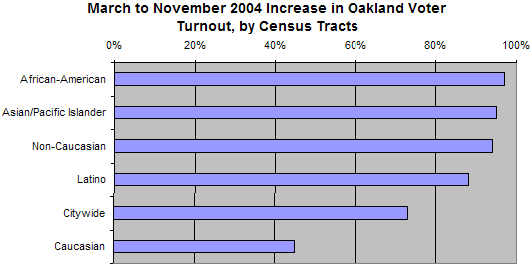At-A-Glance: IRV AND MINORITIES
- IRV ensures that everyone's vote is counted, so it helps all ethnic groups
equally
- Because IRV eliminates the need for a runoff, city elections could be held
in November when there is a higher voter turnout, especially among minorities
where voter turnout has sometimes doubled
- In San Francisco, where IRV was used in 2004, an overwhelming majority of
minorities preferred IRV to the traditional system
- IRV has wide support among Civil Rights activists, including Barack Obama
and Jesse Jackson Jr.
IRV and Minorities
As an election system, IRV does not advantage any ethnic group over another.
However, because IRV promotes voter participation it can especially benefit
minority groups where voter turnout is traditionally lower.
The current two-election runoff system often disproportionately underrepresents
minorities who are less likely to vote in primary elections. In the 2004 local elections, for example,
voter turnout in predominantly (over 60%) white census tracts was 62 percent, whereas
turnout in predominantly non-white census tracts was only 38 percent.
Since an IRV election takes place on one day without the need for a runoff election,
Oakland's local elections could be re-scheduled with the General Election, in November, when
voter turnout is highest for all ethnicities. In 2004, for example, minority voter turnout
doubled from March to November. This means that many more minorities would take part in choosing
the elected officials that are to represent them.
 Because IRV promotes electoral fairness and maximizes voter turnout, groups like
the Greenlining Institute, the Spanish Speaking Citizens Foundation, California NAACP
(Youth & College Division), and Corinne Jan of Family Bridges (formerly Oakland Chinese
Community Council) have endorsed Measure O. In fact, at the national level, minorities
like Jesse Jackson Jr., Barack Obama, Cynthia McKinney, and Barbara Lee have been at the forefront
of this important electoral reform!
Some IRV critics fear that minorities will not be able to understand IRV.
However, polling after San Francisco's first citywide IRV election in 2005 proved that
this fear was unfounded: More than 80 percent of each ethnic group reported
understanding IRV at least fairly well. In fact, contrary to critics accusations,
Spanish-speakers reported the highest levels of voter understanding. More importantly,
even voters who did not understand how IRV worked most likely still knew to rank candidates
by preference and were therefore able to still validly vote. With more education and outreach,
as well as elections, IRV will become standard knowledge.
 Interestingly, the first time IRV was used in the United States, it enabled
a black civil rights activist to be elected. Democrat Albert Wheeler's 1975
election as mayor of Ann Arbor, Michigan would not have been possible without
IRV. In 1971, under the traditional voting system, a Republican won the mayor's
office with 47 percent of ballots cast because the majority progressive vote was
split between the Democrat candidate and by the Human Rights Party. With IRV in
place for 1975, the Human Rights Party no longer spoiled the election, and Mr.
Wheeler was elected. This example illustrates a key principle of IRV, which
allows voters, including minorities, to vote for candidates who share their
values without fear of splitting their voting power.
Resources
Return to the Oakland IRV Home.
|
 |
 |
 |